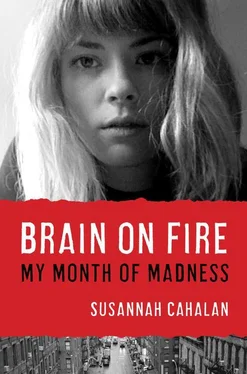End of video.
CHAPTER 22
A BEAUTIFUL MESS
Troubling new symptoms cropped up in the beginning of the second week. My mother had arrived midmorning to find that my slurring of words had worsened so considerably that it was as if my tongue was five sizes too big for my mouth. This scared her more than the hallucinations, the paranoia, and the escape attempts: this was measurable, consistent change, but in decidedly the wrong direction. My tongue twisted when I spoke; I drooled and, when I was tired, let my tongue hang out of the side of my mouth like an overheated dog; I spoke in garbled sentences; I coughed when I drank liquids, which required that I drink water out of a cup that dispensed only a tablespoon of liquid at a time; I also stopped speaking in full sentences, moving from unintelligible ramblings to monosyllables and sometimes just grunts. “Can you repeat after me?” Dr. Russo, the neurologist, asked. “Ca, ca, ca.”
But the hard sounds of the c’s coming from my mouth were so softened that the consonant became unrecognizable, more like “dtha, dtha, dtha.”
“Would you please puff out your cheeks, like this?” Dr. Russo asked, blowing into her closed mouth, extending her cheeks. I pursed my lips and mimed the doctor, but the air would not fill my cheeks. I just exhaled.
“Will you point your tongue out all the way at me?”
My tongue would extend only about half the length of a normal person’s, and even so, it quivered as if strained by the action.
Later that day, Dr. Arslan confirmed Dr. Russo’s new findings, noting my slurred speech in his progress report. I was also making constant chewing motions, not unlike the lip licking in Summit the week before. And now I was making weird grimaces too. My arms kept stiffening out in front of me, as if I was reaching for something that wasn’t there. The team suspected that these behaviors, combined with the high blood pressure and increased heart rate, pointed to a problem in my brain stem or limbic system.
At the top of the spinal cord and at the underside of the brain is the brain stem, one of the more primitive parts of the brain, which helps oversee basic life-or-death functions. 25A thumb-sized cluster of cells in the brain stem called the medulla manages blood pressure, heart rate, and breathing. A bulging area nearby, the pons, plays an important role in the control of facial expressions, so it made sense that my symptoms might be coming from this area.
Still, it’s hard to lay blame. Many areas of the brain are also involved with these kinds of intrinsic functions. Other possible culprits are the insular cortex, located between the frontal and temporal lobes, which is involved with emotion and maintenance of the body’s internal environment; or they could be caused by parts of the limbic system, such as the amygdala and the cingulate gyrus, which are involved with respiratory control.
To return to the analogy of the Christmas lights, even if just one area goes out, many different connections may be altered. It’s often difficult to locate one area and make a causal connection to basic functions or behavior. Just like everything else in the brain, it’s complicated. Or, as author William F. Allman put it in Apprentices of Wonder: Inside the Neural Network Revolution, “The brain is a monstrous, beautiful mess.” 26
Dr. Siegel (my mom’s beloved “Bugsy”) arrived with news shortly after Dr. Arslan had left. “All right, we have something,” he said, speaking rapidly.
“Something?” my mother asked.
“Her spinal tap showed a slightly elevated level of white blood cells. This is typically a sign that there is some kind of infection or inflammation,” he said. There were twenty white blood cells in my spinal fluid in about a microliter of fluid; in a healthy person’s spinal fluid, there should be only zero to five. It was enough for the doctors to wonder, but there were various theories as to why they were there. One of the possible explanations was that they’d been caused by the trauma of the spinal tap itself. Still, it was an indication that something was awry.
“We don’t know what it means yet,” Dr. Siegel said. “We’ve got dozens of tests going. We’ll figure it out. I promise you we will figure it out.”
My mother smiled for the first time in weeks. It was a strange relief for her to finally have confirmation that something physical, as opposed to emotional, was happening to me. She desperately wanted something—anything that she could wrap her mind around. And although this white blood cell clue was vague, it was nonetheless a clue. She went home and spent the rest of the evening on Google, researching what this news could mean. The possibilities were frightening: meningitis, tumor, stroke, multiple sclerosis. Eventually a phone call interrupted her research trance. My voice on the other end sounded like a developmentally delayed child.
“I peed.”
“What happened?”
“I peed. They’re yelling.”
“Who’s yelling at you?” She could hear voices in the background.
“Nurses. I peed. I didn’t mean to.”
“Susannah. They’re not mad at you. I promise. It’s their job to clean it up. They know you didn’t do it on purpose.”
“They’re yelling at me.”
“I promise you it’s not a big deal. It happens. They shouldn’t yell. It was a mistake.” She couldn’t tell what was real and what had been engineered by my tortured mind. Allen agreed that it was likely the latter; either way, they never heard anything more about the incident.
. . .
Because I was still paranoid about work and seemed ashamed about my condition, my parents kept my hospital stay a secret from almost everyone, even my brother. But on Tuesday, March 31, as the first week folded into a second, my parents allowed my first nonfamily friend, Katie, to come visit me. Katie and I had met in college and bonded over a shared love for Loretta Lynn, soul music, vintage clothes, and stiff St. Louis cocktails. Katie was vibrant, a bit goofy, and a great partner in crime. Not knowing what to bring, she purchased a stuffed rat (Katie in a nutshell: a rat instead of a teddy bear), a DVD of gangster rap videos, and a subtitled French film, not realizing that I could no longer read.
Katie now worked as a teacher in Queens and had coached many children with serious social issues and learning difficulties, but she was unprepared for what she found on the other side of the hospital door. This new me was physically different: skinny and pale, cheeks sunken in, and thighs whittled down to toothpicks. My eyes were glazed over. Trying to break the ice, Katie gossiped about people we had gone to college with, knowing that her role was to distract me from the serious matters around me. But it was hard to maintain a conversation because I operated on a delay, responding to basic questions several seconds after they were posed. And then there was the problem of my speech. I had been a professional conversationalist, normally the kind of person who could make small talk with a brick wall, but this new me struggled with even the simplest statements. Most of the time Katie couldn’t even make out what I was saying.
“Let’s go for a walk,” Katie suggested, joking, “Don’t forget your Dora the Explorer backpack.” It took me several moments to realize that Katie was referring to the little pink bag that carried my EEG wires, but eventually I laughed. We shuffled slowly to the waiting area and sat on two chairs facing away from the windows. Katie noticed how baggy my black leggings were.
“You’re so skinny, Susannah!”
I looked down at my legs for a moment, like I was discovering a new part of my body. I laughed and said: “Theeeeessssseearrrrre my legggggggggggings! My legggggggggings! My legggggggggggings!” and got out of my seat to perform an awkward Irish jig. Weird, yes, but I was dancing, so Katie took that as a good sign.
Читать дальше













